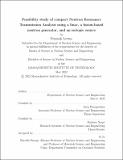Feasibility study of compact Neutron Resonance Transmission Analysis using a linac, a fusion-based neutron generator, and an isotopic source
Author(s)
Levine, Peninah
DownloadThesis PDF (5.273Mb)
Advisor
Danagoulian, Areg
Terms of use
Metadata
Show full item recordAbstract
Various nuclear security applications such as fuel enrichment analysis and warhead verification seek to identify nuclear materials in a black box target. Neutron Resonance Transmission Analysis (NRTA) is a spectroscopic technique which uses resonant neutron absorption to identify isotopic compositions. Previous NRTA experiments have used expensive beam line facilities with kilometer-long accelerators. This work explores feasibility of compact NRTA configurations using a linear accelerator (linac), fusion-based neutron generator, and isotopic source. Monte Carlo simulations show that these configurations trade off between complexity and flux, which is related to measurement time. A 5.5 MeV linac may yield the highest epithermal (1-10 eV) neutron flux (10⁷ neutrons s⁻¹), but conversion of electrons to neutrons adds complexity, bulk, and expense. A deuterium-tritium (DT) fusion-based neutron generator produces a moderate neutron flux (10⁶ neutrons/s) and complexity relative to the linac and isotopic configurations. Isotopic NRTA may provide the simplest solution but limits flux to 10⁴ neutrons s⁻¹. Preliminary isotopic experiments indicate that limited source activity poses a challenge for overcoming gamma background. This thesis discusses feasibility of each proposed NRTA setup in various security applications.
Date issued
2022-05Department
Massachusetts Institute of Technology. Department of Nuclear Science and EngineeringPublisher
Massachusetts Institute of Technology